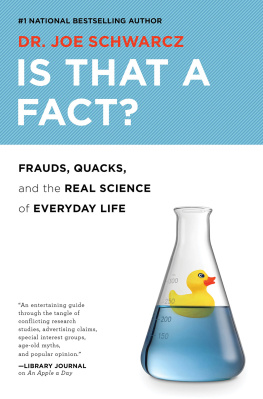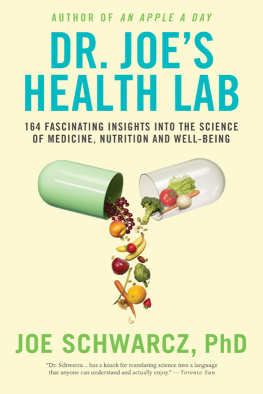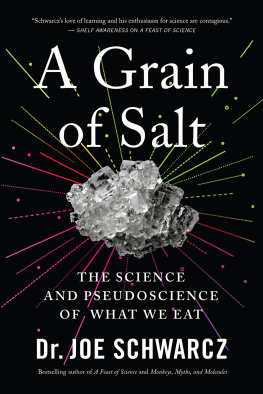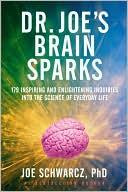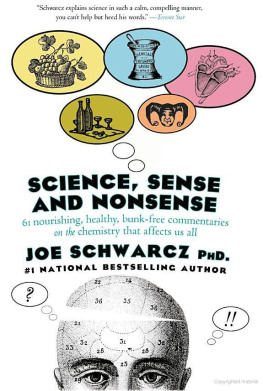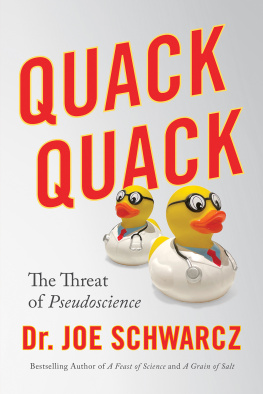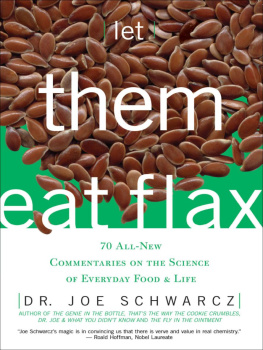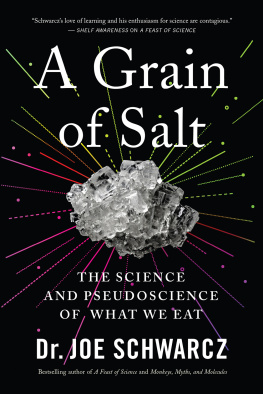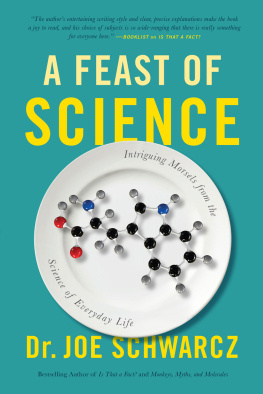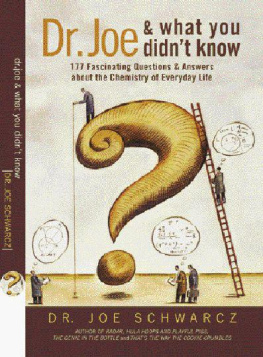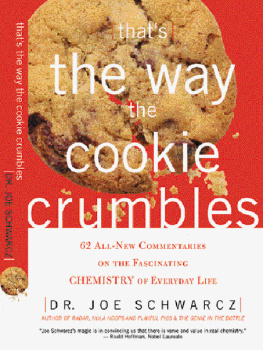Joe Schwarcz - Science, Sense & Nonsense
Here you can read online Joe Schwarcz - Science, Sense & Nonsense full text of the book (entire story) in english for free. Download pdf and epub, get meaning, cover and reviews about this ebook. year: 2008, publisher: Doubleday Canada, genre: Children. Description of the work, (preface) as well as reviews are available. Best literature library LitArk.com created for fans of good reading and offers a wide selection of genres:
Romance novel
Science fiction
Adventure
Detective
Science
History
Home and family
Prose
Art
Politics
Computer
Non-fiction
Religion
Business
Children
Humor
Choose a favorite category and find really read worthwhile books. Enjoy immersion in the world of imagination, feel the emotions of the characters or learn something new for yourself, make an fascinating discovery.

- Book:Science, Sense & Nonsense
- Author:
- Publisher:Doubleday Canada
- Genre:
- Year:2008
- Rating:3 / 5
- Favourites:Add to favourites
- Your mark:
- 60
- 1
- 2
- 3
- 4
- 5
Science, Sense & Nonsense: summary, description and annotation
We offer to read an annotation, description, summary or preface (depends on what the author of the book "Science, Sense & Nonsense" wrote himself). If you haven't found the necessary information about the book — write in the comments, we will try to find it.
Joe Schwarcz: author's other books
Who wrote Science, Sense & Nonsense? Find out the surname, the name of the author of the book and a list of all author's works by series.
Science, Sense & Nonsense — read online for free the complete book (whole text) full work
Below is the text of the book, divided by pages. System saving the place of the last page read, allows you to conveniently read the book "Science, Sense & Nonsense" online for free, without having to search again every time where you left off. Put a bookmark, and you can go to the page where you finished reading at any time.
Font size:
Interval:
Bookmark:
MAKING SENSE OF IT ALL
W hy does a shower curtain get drawn in when taking a shower? How do two-in-one shampoos work? If nothing sticks to Teflon, how do they get it to stick to the pan? These are the typical kinds of questions I used to get on my radio show or after my public lectures. But my, oh my, how times have changed. These days, a question about shower curtains is likely to be about the release of phthalates; with shampoos, about the presence of parabens; and as far as non-stick cookware goes, Im more likely to get sticky questions about health risks than cooking properties.
In general, questions tend to be in the How much should I worry about such-and-such? category. Depending on whats been in the news, the concern may be over fire retardants in upholstery, drug residues in drinking water, formaldehyde in bras, diisocyanates in mattresses, bisphenol A in canned food, trichloroethylene in groundwater, dioxins in meat, mercury in vaccines, pesticide residues in food or radiation emanating from granite countertops. Curiosity about what we can do with chemicals has been replaced by fear of what chemicals can do to us.
All of this is very understandable, given that loss of health is our greatest fear in life. So, what can we do to prevent illness? Lifestyle factors such as proper nutrition, weight control and exercise are important. We also know that radiation, cigarette smoke and occupational exposure to certain chemicals can impact on health. But until recently, not much attention has been paid to exposure to the tiny amounts of chemicals that show up in the environment as a result of chemical innovations introduced since the end of the Second World War. Thousands of chemicals that never existed before are now produced in dazzling amounts and sometimes show up in unexpected placeslike our bodies. Almost daily, media reports alert us not only to the presence of these chemicals, but to their potential for undermining our health.
Why is there so much interest in these environmental contaminants of late? First of all, we used to have bigger fish to fry. When you are concerned about improving food production, controlling malaria or battling infections, you tend not to sweat the small stuffespecially if you dont even know that the small stuff is there. Now, thanks to recent advances in technology, we know. Of course, it was always reasonable to suspect that our massive chemical production must leave some sort of environmental footprint, but we didnt worry much because of our reliance on the mantra of toxicology, namely that only the dose makes the poison. We assumed that if we couldnt detect it, it couldnt be doing any harm.
Times have changed. Chemicals can now be detected at levels of parts per trillion, or sometimes even lower. And we have accumulating evidence that some, especially those that can mimic the effect of hormones, can produce physiological effects at such incredibly small concentrations. There is something else that we now have: much better information about disease incidence and disease patterns. Rates of childhood cancer have increased since the 1950s, as have prostate and breast cancers, both of which have a hormonal connection. Some of the increase undoubtedly can be attributed to better diagnostic techniques, but something else seems to be going on as well. The question is what. And there are experts aplenty who claim to know the answer. But the problem is that they all have different answers.
Research these days has become very specialized. Scientists who study the effects of bisphenol A released from plastics, for example, may know nothing about the work being done on phthalates or brominated diphenyl ethers or beryllium or electromagnetic radiation. Indeed, they may not even be aware of the existence of these fields of research. They live in separate worlds, the only common feature being the presence in each of these worlds of scientists, physicians or self-proclaimed experts who claim that our health problems are caused by their pet culprit. You can take your pick from plasticizers, dioxins, chlorates, air particulates, perfluorooctanoates or a slew of others. Since we are exposed to most of these to some extent, if the claims of harm were all true, we would be dropping like flies.
This is not to suggest that such environmental contaminants cannot have an effect on our health. They almost surely can. But teasing out which ones, and under what conditions they may cause harm, is a daunting task with many possible pitfalls. For example, a type of rat known as the Sprague Dawley is commonly used to evaluate compounds that may either mimic or block the activity of natural hormones. This rodent, though, has been bred to reproduce in a prolific fashion and has a hormonal constitution that may be more resistant to endocrine-disrupting chemicals. Probably not a good model for humans.
Any alteration in the genes that make up DNA upon exposure to a chemical is also a basis for determining toxicity, but we now know that certain chemicals can significantly affect the functioning of DNA without altering its structure. The burgeoning field of epigenetics deals with the notion of chemicals turning genes on or off without affecting their structure. A chemical, such as bisphenol A, for example, may deactivate a gene that codes for the production of a protein that helps protect a cell from cancer. Epigenetic research will probably be able to help focus our worries.
Cherry-picking data, a common process for people or organizations with agendas, is not the way to do science. Environmentalists, industry representatives, activists of all sorts and even government officials are in on the cherry harvest, selecting data that support a particular position, usually a controversial one, while ignoring relevant contradictory evidence. Of course, these days there is no shortage of scientific controversies. Concerns over the safety of plastic components, cosmetic ingredients, medications, pesticides, genetically modified organisms, cell phones, microwave ovens, drinking water and food are very much in the public eye. People search for guidance in tackling these issues, and they look for dispassionate, unbiased answers. In theory, that is just what scientific research should be able to deliver.
In the best of all possible worlds, scientists would all be competent, would have no preconceived biases, would not be driven by monetary gain, would have access to plentiful funding from unbiased sources and would have their egos safely tucked away. Alas, we do not live in Utopia. Indeed, the only uncontestable remark that can be made about current scientific research is that it is plentiful. Actually, that is an understatementits sheer volume is mind-boggling. Thousands of peer-reviewed research papers are published every week, and they are obviously not all of equal quality. Contradictory findings are not uncommon, even in the absence of any bias. As a result, scientific publications can be found to support almost any point of view. You just have to be prepared to do a little cherry-picking.
If you want to prove that the pesticide DDT was responsible for an increase in breast cancer on New Yorks Long Island, you can certainly find peer-reviewed publications to back up the claim. But you can also prove the opposite by pointing at a seven-year federally funded study that showed no such effect. Studies can be found linking bisphenol A with developmental problems in rodents, but the literature also reveals plenty of studies absolving the chemical of blame. Antioxidant supplements are effective in warding off disease according to some studies, and useless according to others. This doesnt mean that any of the studies are wrong; it just highlights the difficulty of obtaining conclusive results when many variables are involved. Thats just the nature of science.
But science gets short-shifted and the public ends up being misled when data are presented selectively to support an agenda. And when the stakes are high, this is almost inevitable. Unfortunately, at McGills Office for Science and Society, we witness this on a daily basis as we try to make heads or tails of scientific controversies. Some public-spirited group will get on its high horse and claim, with supporting studies, that one chemical or another in our environment is wreaking havoc with our health. Industry then responds by circling its wagons and trotting out contradictory studies. Both sides sound convincing. Governments get involved, but any action has to take both activist and corporate sensitivities into account. There is name-calling aplenty on all sides, with the combatants attempting to outmuscle each other by enlisting reputable scientists to further their causes. These scientists may be hired directly by the organizations involved, they may have connections through sponsored research, or they may just support a certain view out of conviction. Each of these scenarios raises concerns.
Font size:
Interval:
Bookmark:
Similar books «Science, Sense & Nonsense»
Look at similar books to Science, Sense & Nonsense. We have selected literature similar in name and meaning in the hope of providing readers with more options to find new, interesting, not yet read works.
Discussion, reviews of the book Science, Sense & Nonsense and just readers' own opinions. Leave your comments, write what you think about the work, its meaning or the main characters. Specify what exactly you liked and what you didn't like, and why you think so.


